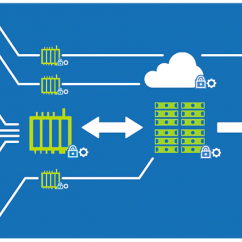We will discuss this matter with Mr. Antuan Angelov, Development and Integration Solutions Manager at KONTRAX AD.
Listen to the full interview on Darik Radio on 12.02.2019, Tuesday, from 8h00 to 9h30.
1. What are the common things between the Fourth Industrial Revolution, IIA, IIoT, and the Data-Driven Production?
According to the forecasts, the "Internet of Things" will reach 26 billion connected devices by the Year 2020. Thus, the industry faces a new challenge - real-time storage and efficient analysis of the incoming huge amounts of data that provide all kinds of sensors. Nowadays, machines in production are driven by controllers and software systems functioning autonomously and incompatible between one another. On the other hand, in production, not all the available data generated by machines are addressed. But the added value needed to solve real problems in the production process can be extracted with a little control and in combination with the Big Data and Analysis. We can give an example of a robotic hand that arranges the sweets in the candy bar. To analyse the image from the camera, specialized software is used and the robot receives a feedback on the details of the task to be executed. However, in the process of candy production, besides the particular robot, other machinery and equipment such as syringes, mixers, etc. are also incorporated. In practice, it appears that the overall picture of the production line remains incomplete. Therefore, it is increasingly said that the fourth industrial revolution, which incorporates another key component – Internet connectivity – is currently underway. It generates new technological trends, both in the direction of data collection and their subsequent analysis and processing.
Last but not least, the implementation of the most difficult task in the process is to be carried out – the convergence between the human qualities and the robot capacities, in particular the full integration with the Artificial Intelligence. More and more low-skilled workers performing repetitive tasks will be replaced by automated robotic systems and Artificial Intelligence. This will necessitate the re-qualification and training of staff to take more intellectual activities.
2. In what direction the process of automation and production can improve?
Industrial Internet of Things (IIoT) has already produced significant changes in three main trends: expansion of sensors in our daily lives, availability of inexpensive storage and better equipment for easy and accessible communications. The presence of new, built-in sensors, combined with advances in connectivity, security, interoperability and analysis, creates potential abilities to enhance the production process. Companies that collect, merge and analyse a variety of data, such as information on the equipment operation or human operator data, will stand out from thier competition through better informed decision-making.
Another example of production - where an Industrial Internet of Things is used – is the robotic manufacturing arm that automatically attaches nuts to a bolt. The hand has a 3D laser scanner to identify the parts, to take the right nut, to screw the bolt nut, to check and adjust the torque and then to move. This process involves operations such as finding the right parts, guiding and turning the nut with the correct torque, etc.). These specific parameters must be monitored and controlled continuously. Therefore, many different types of sensors are involved. They all have to transmit their data to a centralized server. To achieve maximum efficiency a real-time software automatically selects different torques.
The data-driven management approach, along with the Industry's Internet of Things, extends the operating time of an equipment, increases productivity, provides predictable equipment maintenance, reduces component failures, and limits unnecessary costs.
Artificial Intelligence and different algorithms for optimization and self-learning are the only solution for data analysis. As a result, innovative industries will enjoy competitive advantages such as:
- Enhanced process performance
- Better decision-making
- Improved staff productivity
- Reduced waiting or idle time of machinery/ asset
- Effective use of assets
- Better work with suppliers/customers
3. What kind of solutions could KONTRAX and Dell EMC offer to upgrade the production and automation in the direction of intelligent management?
For many years, KONTRAX is a system integrator in Bulgaria and a traditional supplier of IT solutions for the production. At present, the Company offers successful software solutions intended to the entire production process: design, construction, testing and manufacturing. For many years, KONTRAX is also a partner of the US manufacturer Dell EMC in sectors where industry relies entirely on Dell EMC product lines. Edge Gateway is the right series of industrial computers, playing the role of gateways with a special focus on Industry 4.0 the "Internet of Things". These are capable of receiving and exchanging sensor data and providing continuous data exchange to the Cloud or to the control centre under heavy industrial conditions through the powerful Intel® processors. Industrial Dell IoT Gateway (Dell Edge Gateway 5000) supports multiple data exchange protocols. Dell also offers IoT software solutions with a modular approach to provide scalability in the future. These are servers with powerful mathematical co-processors for data processing and analysing.
KONTRAX is a leading system integrator in Bulgaria, having a wide portfolio of technologies and high expertise in the implementation of complex manufacturing solutions, offering together with its long-time partner Dell EMC industrial computers, workstations, servers, networks, storage and data analysis that are the basis for successful IIoT implementation in manufacturing.

